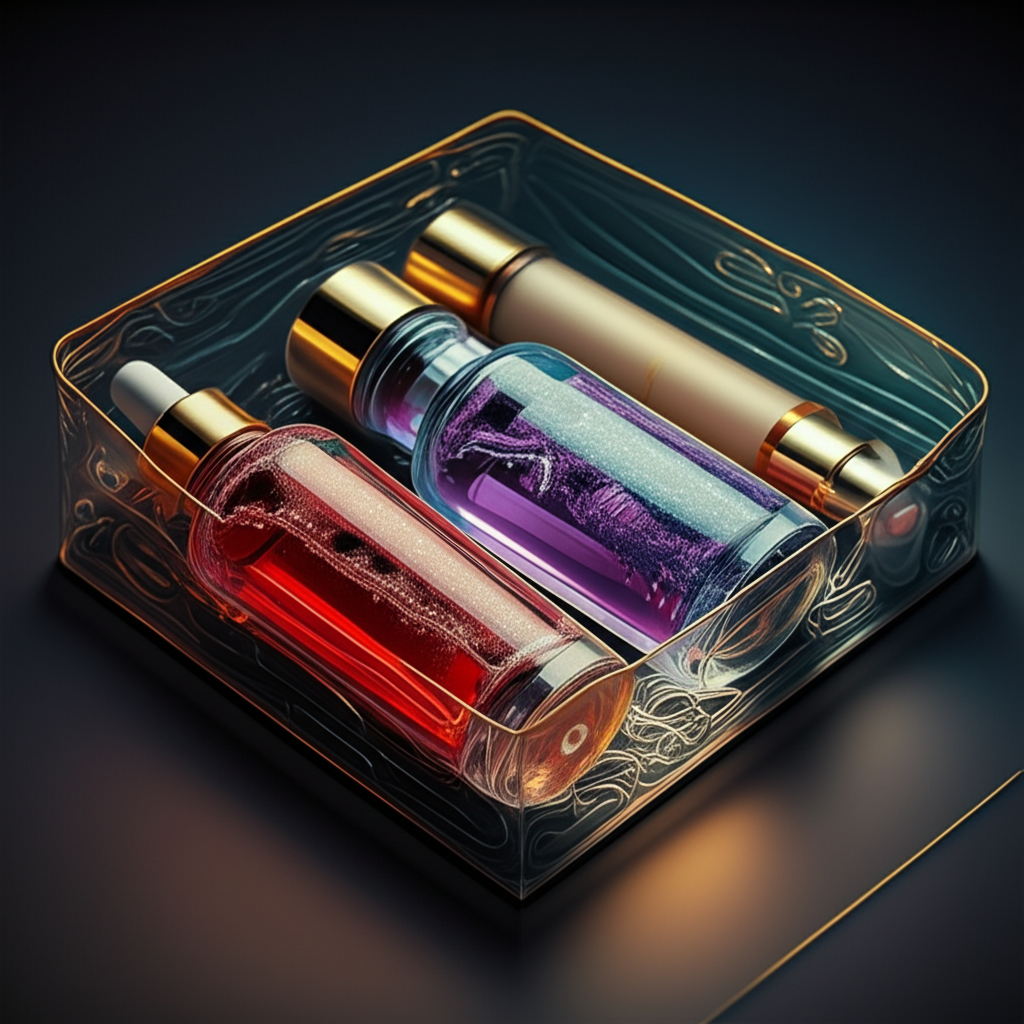Cross-Border Shipping “Nightmare”: The Ultimate Guide to Damage-Proof Packaging for Beauty Products (Glass Bottles/Liquids)
Shipping beauty products across borders, especially fragile glass bottles and liquids, is a major challenge for sellers. High damage rates not only lead to financial losses but also affect brand reputation. This guide will delve into all aspects of damage-proof packaging for cross-border beauty product shipping, providing practical solutions to help your products reach consumers safely.
Introduction: Challenges and Pain Points of Cross-Border Beauty Product Shipping
Imagine carefully selected beauty products traveling a long distance, arriving at the customer's doorstep with anticipation, only to be found with broken bottles and leaking liquids, instantly plummeting the customer experience. This is not an isolated case. According to statistics, up to 15% of beauty products experience some degree of damage during cross-border transportation.
The losses caused by damage are multifaceted:
- Direct Financial Loss: The cost of the product itself and the high international shipping costs are lost.
- Indirect Financial Loss: Returns processing and additional customer service communication consume a lot of manpower and resources.
- Brand Reputation Damage: Negative customer reviews and social media exposure cause irreparable damage to the brand image.
- Reduced Consumer Trust: Affects repurchase rates and even leads to customer churn.
Therefore, specifically addressing the damage-proof packaging problem for cross-border beauty product shipping is a crucial step that cross-border e-commerce sellers must pay attention to. This article will provide comprehensive solutions from multiple dimensions, including risk identification, material selection, packaging design, shipping considerations, and AI technology applications.
Part 1: Risk Identification: Common Causes of Damage to Beauty Products in Cross-Border Transportation
Know yourself and your enemy, and you will never be defeated. Before developing a damage-proof packaging strategy, you must first understand the various risks that beauty products may encounter during cross-border transportation:
- External Impact:
- Collision and Squeezing: Bumpy transportation vehicles and the stacking and squeezing of goods can cause glass bottles to break and plastic bottles to deform. Goods in sea freight containers are particularly vulnerable to squeezing; land freight may experience severe vibrations due to poor road conditions; and even relatively stable air freight cannot completely avoid collisions during handling.
- Drops: Accidental drops during manual handling and loading/unloading are common causes of damage.
- Temperature Changes:
- Liquid Expansion and Contraction: Cross-border transportation often experiences different climate zones with drastic temperature changes. Liquid products may expand when heated, causing loose caps and liquid leakage; low temperatures may increase the viscosity of certain liquids, increasing pressure on the bottle.
- Deformation and Cracking of Packaging Materials: Extreme temperatures can cause certain plastic or paper packaging materials to deform or crack, reducing their protective performance.
- Humidity Effects:
- Softening and Mildew of Paper Packaging: Humid environments can easily cause cardboard boxes to soften, reducing their compressive strength, and even breed mold, affecting the product's appearance.
- Corrosion of Metal Packaging: For beauty products containing metal parts (such as spray cans), humid environments may cause corrosion, affecting product quality and user experience.
- Improper Operation:
- Rough Handling: Some logistics personnel lack professional training and may throw, trample, or engage in other rough handling behaviors during transportation.
- Non-Standard Loading and Unloading: During loading and unloading, goods are not placed reasonably, the center of gravity is unstable, and it is easy to tip over and collide.
- Improper Selection of Packaging Materials:
- Insufficient Strength: Packaging materials cannot withstand the pressure and impact during transportation.
- Poor Cushioning Performance: Unable to effectively absorb vibrations and impacts.
Part 2: Packaging Material Selection: Creating a Strong “Protective Shield”
Choosing the right packaging materials is the first step in damage-proof packaging. Just like choosing a protective case for a mobile phone, beauty products also need a strong “protective shield.”
- Outer Packaging:
- Five-Layer Corrugated Cardboard Box: Strong compression resistance, effectively resists external pressure, and is an ideal choice for long-distance transportation. Especially suitable for larger and heavier products.
- Honeycomb Cardboard Box: Excellent cushioning performance, effectively absorbs impact, and has the advantages of being environmentally friendly and recyclable. Suitable for brands with environmental requirements.
- Plastic Box: Waterproof and moisture-proof, effectively protects products from the effects of humid environments, especially suitable for sea freight. However, the cost is relatively high, and the environmental performance is poor.
- Inner Packaging:
- Bubble Wrap/Bubble Column: Provides comprehensive cushioning protection, effectively absorbs impact, and prevents product collision. Suitable for products of various shapes and easy to use.
- EPE Pearl Cotton: Lightweight, shockproof, heat-insulating, and waterproof, effectively protects products from various environmental factors. Can be cut according to product shape, with strong applicability.
- EPS Foam: Excellent cushioning performance, effectively protects products from severe impact. However, it is not degradable and has a large impact on the environment.
- Corrugated Cardboard/Pulp Molding: Environmentally friendly and recyclable, can be customized into various shapes, effectively fixes products and prevents shaking. Suitable for brands with environmental requirements.
- Fixing Materials:
- Inflatable Air Bags: Fill the gaps in the box to prevent product movement and reduce collision. Easy to use and low cost.
- Expanding Pearl Cotton: Quickly fill gaps and provide extra protection. Can automatically expand according to the size of the gap, with good filling effect.
- Tape: Choose high-viscosity, tear-resistant tape to ensure secure box sealing. It is recommended to use transparent tape for easy customs inspection.
For glass bottle products, it is recommended to use a five-layer corrugated cardboard box as the outer packaging, wrap the inside with bubble wrap or EPE pearl cotton, and fix it with corrugated cardboard or pulp molding.
For liquid products, in addition to choosing a bottle material with good sealing performance, absorbent materials, such as absorbent paper or absorbent cotton, should also be used inside the outer packaging to prevent losses caused by leakage.
Part 3: Packaging Design: Details Determine Success or Failure
Packaging design is not just about aesthetics, but also an important means of protecting products. Optimization in details can often achieve twice the result with half the effort.
- Product Fixation: Ensuring that the product is stable in the packaging box and avoiding shaking is the key. Use liners, partitions, moldings, etc. to firmly fix the product in the packaging box.
- Cushioning Layer: Set up enough cushioning layer around the product to absorb impact. Special attention should be paid to protecting fragile parts, such as bottle necks and bottle caps.
- Space Filling: Fill the gaps in the box to prevent product movement and squeezing. You can use filling air bags, expanding pearl cotton and other materials.
- Packaging Strength: Choose packaging materials of sufficient strength and conduct compression tests to ensure that the packaging can withstand the pressure during transportation.
- Fragile Label: Attach eye-catching fragile labels on the outer box, such as “Fragile” and “Handle with Care”, to remind handlers to handle with care.
- Moisture-Proof Treatment: For products that are susceptible to moisture, carry out moisture-proof treatment, such as using desiccants and moisture-proof films.
- Customized Design: For specific products, customize the packaging plan to provide the best protection. For example, for special-shaped bottles, you can customize molded liners.
Part 4: Precautions During Transportation: Reduce the Risk of Damage
In addition to packaging, some precautions during transportation can also effectively reduce the risk of damage.
- Choose the Right Logistics Company: Choose an experienced and reputable logistics company, and understand its professional capabilities and services in the transportation of fragile goods. You can consult other sellers to understand the reputation of different logistics companies.
- Purchase Transportation Insurance: Purchase transportation insurance, in case of damage, you can get compensation. This is an important means to reduce risk.
- Reasonably Arrange Transportation Routes: Avoid congested road sections and choose stable transportation routes. You can communicate with the logistics company to choose the best route.
- Temperature Control: For temperature-sensitive products, choose temperature-controlled transportation methods. For example, cold chain transportation can ensure that the product is transported at a constant temperature.
- Track Logistics Information: Track logistics information in a timely manner to understand the product transportation status. You can track through the logistics company's website or APP.
- Communicate with the Logistics Company: Maintain communication with the logistics company and deal with possible problems in a timely manner. For example, if you find transportation abnormalities, contact the logistics company in a timely manner.
Part 5: Using AI Technology to Optimize Packaging Solutions
With the development of artificial intelligence technology, the application of AI in the packaging field is becoming more and more extensive. Using AI technology can more effectively optimize packaging solutions, improve damage-proof performance, and reduce costs.
- AI Simulation: Use AI to simulate various situations during transportation, such as collision, drop, squeezing, etc., predict the stress of the packaging, find weak links, and optimize them.
- AI Optimization: Based on massive data, AI can analyze the performance of different packaging materials, such as compressive strength, cushioning performance, temperature resistance, etc., and recommend the best combination of materials.
- AI Customization: AI can automatically generate customized packaging solutions according to the product's shape, size, weight and other information, without manual design, improving efficiency.
- AI Detection: Use AI visual recognition technology to detect whether there are defects in the packaging, such as damaged cartons and loose tape, and find potential risks in a timely manner.
AI has significant advantages in improving packaging efficiency, reducing costs, and improving damage-proof performance, and is the future trend of packaging development.
Part 6: Successful Case Sharing
Here are some successful cases of damage-proof packaging for cross-border beauty product transportation. Although the brand information is hidden, the effectiveness of the packaging solution is highlighted:
- Case 1: A brand reduced the breakage rate of glass bottles from the original 8% to 2% by optimizing the internal packaging design and using a combination of honeycomb cardboard and pearl cotton.
- Case 2: A brand adopted a new type of polymer cushioning material, which effectively coped with the severe vibrations during transportation, and reduced the leakage rate of liquid products by 5%.
- Case 3: A brand used AI technology to optimize the packaging solution. Through AI simulation, the weak links of the packaging were found and strengthened, saving 10% of the packaging cost and improving the damage-proof performance.
Conclusion: Cross-Border Beauty Product Transportation, Safe Packaging is Key
For cross-border transportation of beauty products, damage-proof packaging is the key, which directly affects product safety and brand reputation. Choosing the right packaging materials, optimizing packaging design, and paying attention to details during transportation are important guarantees to ensure that products arrive safely in the hands of consumers.
With the development of technology, AI will play a greater role in the packaging field, providing safer and more efficient solutions for cross-border transportation. In the future, we can expect more innovative technologies to be applied to the packaging field, bringing more convenience to cross-border e-commerce sellers.

